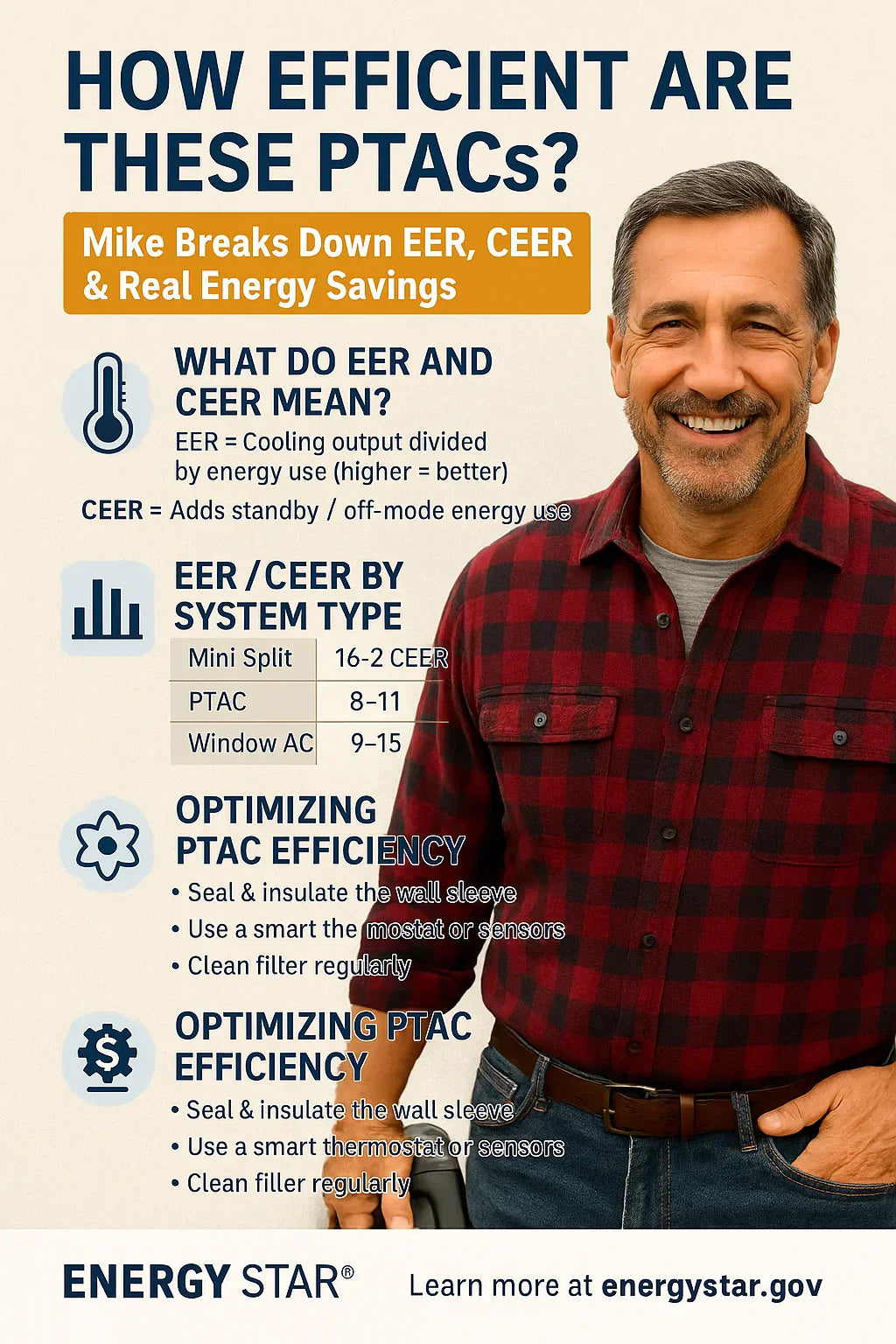Introduction: Why Efficiency Matters More Than Ever
Mike is a homeowner who recently upgraded his basement apartment and needed a heating and cooling system that was reliable, efficient, and didn't kill his electric bill. Like many homeowners and property managers, he was initially drawn to PTAC (Packaged Terminal Air Conditioner) units for their compact design and affordability. But the real question was: how much energy would they actually use?
That’s when Mike went down the rabbit hole of efficiency metrics: EER, CEER, Energy Star certifications, and cost-per-BTU breakdowns. This guide walks through what Mike learned so you can make the smartest possible choice before you buy.
What Do EER and CEER Actually Mean?
EER (Energy Efficiency Ratio)
EER measures how efficiently a PTAC unit can cool your space. It’s calculated as:
EER = Cooling Capacity (BTU/hr) / Power Input (Watts)
So, if a PTAC unit delivers 12,000 BTUs and draws 1,200 watts:
EER = 12,000 / 1,200 = 10.0
Higher EER = more efficient cooling.
CEER (Combined Energy Efficiency Ratio)
CEER takes EER and adds in the unit’s standby power usage, which means it includes power consumed when the system isn’t actively cooling.
This is a more realistic efficiency rating for modern use, especially if your PTAC is in a hotel, rental suite, or guest room.
CEER = Total BTUs / (Active + Standby Power Consumption)
EER vs. CEER: Which Should You Use?
-
CEER is required for Energy Star ratings and reflects actual energy usage more accurately.
-
EER is still widely published and useful when comparing models side by side.
PTACs vs. Mini Splits vs. Window ACs: Efficiency Showdown
| System Type | Average CEER | Energy Star Eligible? | Common Use Case |
|---|---|---|---|
| PTAC Unit | 9.5–11.5 | Yes (if CEER > 10.5) | Hotels, apartments |
| Mini Split System | 13–22+ | Yes | Whole-home zoning |
| Window AC | 9–12 | Yes | Single rooms, rentals |
Mike’s Tip: PTACs tend to trail mini splits in pure efficiency, but beat them in upfront cost and ease of installation—especially in retrofit or commercial settings.
Top Energy-Efficient PTACs (2025 Models Mike Compared)
| Brand | Model | BTU Rating | CEER | Voltage | Heating Type |
| GE | AJEQ12DWH | 12,000 | 11.0 | 230V | Electric Heat |
| Amana | PTC153G35AXXX | 15,000 | 10.5 | 208/230 | Electric Heat |
| Hotpoint | AH12H15D3B | 15,000 | ~9.5 | 230V | Electric Heat |
Mike found all three models on The Furnace Outlet, already packaged with the wall sleeve and grille—a must for sealing in savings.
How Much Can You Save? Real-World Examples
Using the Energy Star calculator, here’s what Mike estimated for his 300-square-foot rental:
Scenario 1: Lower Efficiency PTAC (~9.5 CEER)
-
Annual runtime: 1,200 hours
-
Energy use: ~1,263 kWh/year
-
Annual cost (at $0.15/kWh): $189.45
Scenario 2: High Efficiency PTAC (11.0 CEER)
-
Energy use: ~1,090 kWh/year
-
Annual cost: $163.50
Savings per year: ~$26 Savings over 10 years: ~$260
Bonus: Some local utilities offer $50–200 rebates on Energy Star PTACs.
Mike’s Checklist: How to Maximize PTAC Efficiency
-
Seal the Sleeve: Make sure there’s no air leakage around the wall sleeve—use foam insulation strips or caulk.
-
Insulate Around the Frame: If your unit is in an exterior wall, make sure the cutout isn’t leaking air.
-
Use a Smart Thermostat: Schedule run times based on room usage (great for guest spaces).
-
Clean the Filter Monthly: Dust, hair, and debris force the motor to work harder.
-
Flush the Condensate Drain: Prevents water buildup and mold.
-
Switch to Heat Pump (If Climate Allows): Mike chose electric heat due to his location, but heat pump PTACs are often more efficient in moderate climates.
Should You Upgrade? Signs Your Old PTAC Is Wasting Energy
-
Compressor runs constantly or cycles frequently
-
Vents clogged with dust or mold
-
Rattling or buzzing during operation
-
No Energy Star label (or CEER below 9.0)
-
Cold drafts from around the unit
Mike’s original unit was from 2008 and had an EER of just 8.5—upgrading made an immediate impact on comfort and costs.
Rebates, Tax Credits & ENERGY STAR Perks (2025 Update)
-
Federal Tax Credit: Up to 30% off installed cost of Energy Star-certified HVAC (check Form 5695).
-
State/Utility Rebates: Many states offer PTAC-specific rebates.
-
Database of State Incentives for Renewables & Efficiency (DSIRE)
Mike’s Final Thoughts
Mike ultimately went with the GE Zoneline AJEQ12DWH because of its high CEER, Energy Star certification, and solid reputation. He installed it with a sealed wall sleeve, added foam around the interior edges, and installed a programmable wall thermostat.
His power bill dropped by about 12% in the first two months, and the guest suite was noticeably quieter and more comfortable.
"Don’t let the sticker price fool you. When you look at power bills over five years, efficiency wins every time."
Ready to Buy Smarter? Browse The Furnace Outlet’s Best-Selling PTACs to compare CEER ratings, heating types, and installation bundles.
In the next topic we will know more about: What’s in the Box? Unboxing the Top-Selling PTAC Models Before You Install







